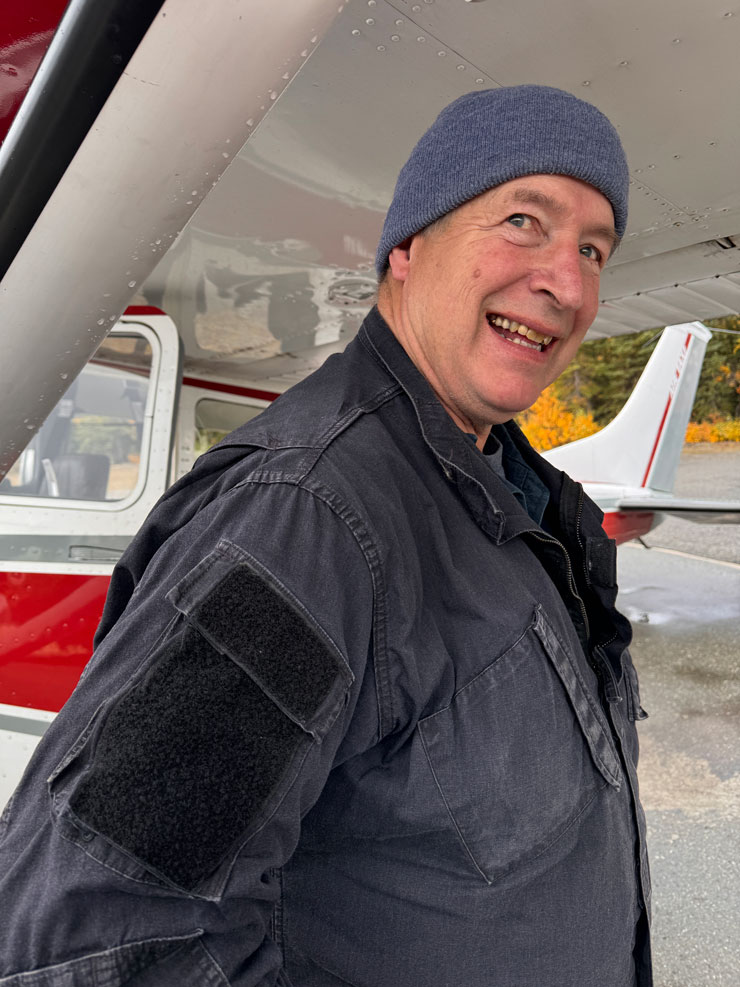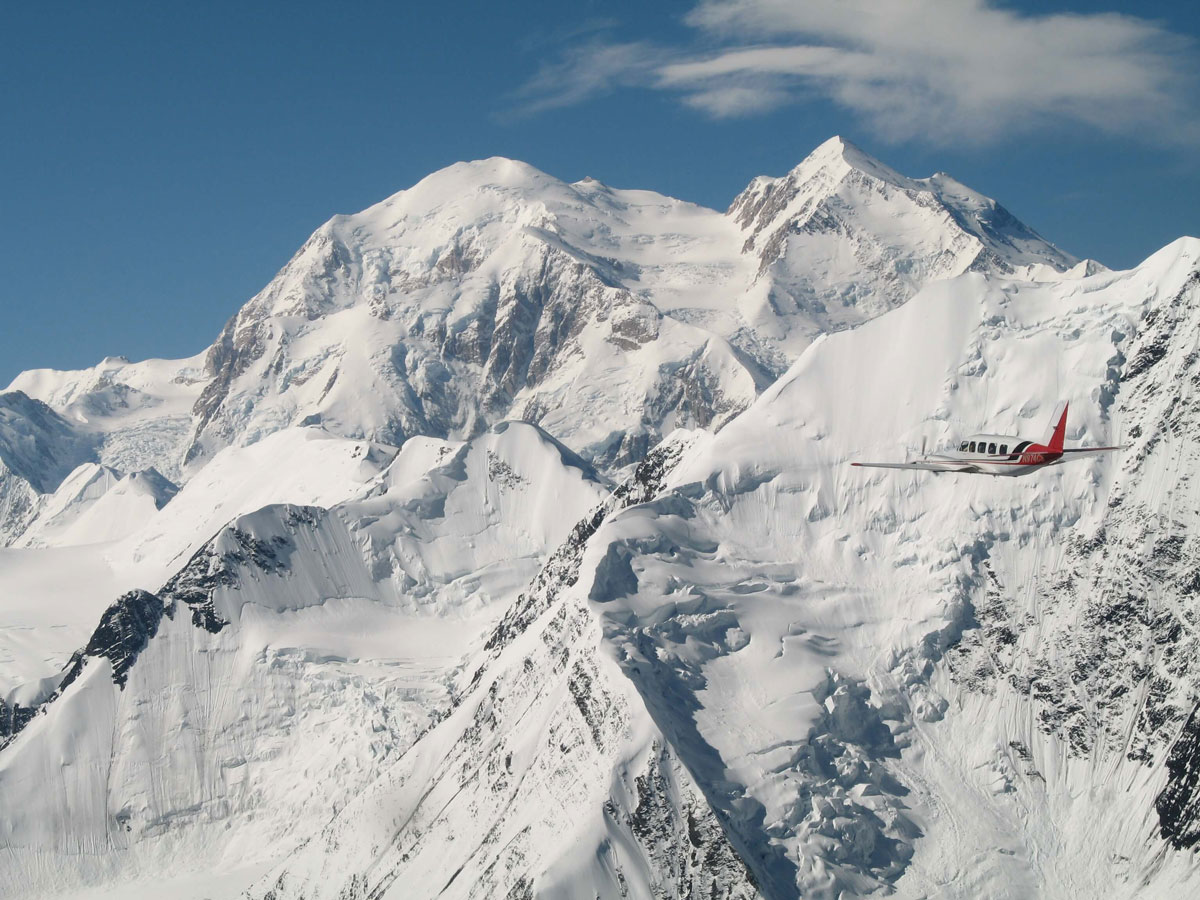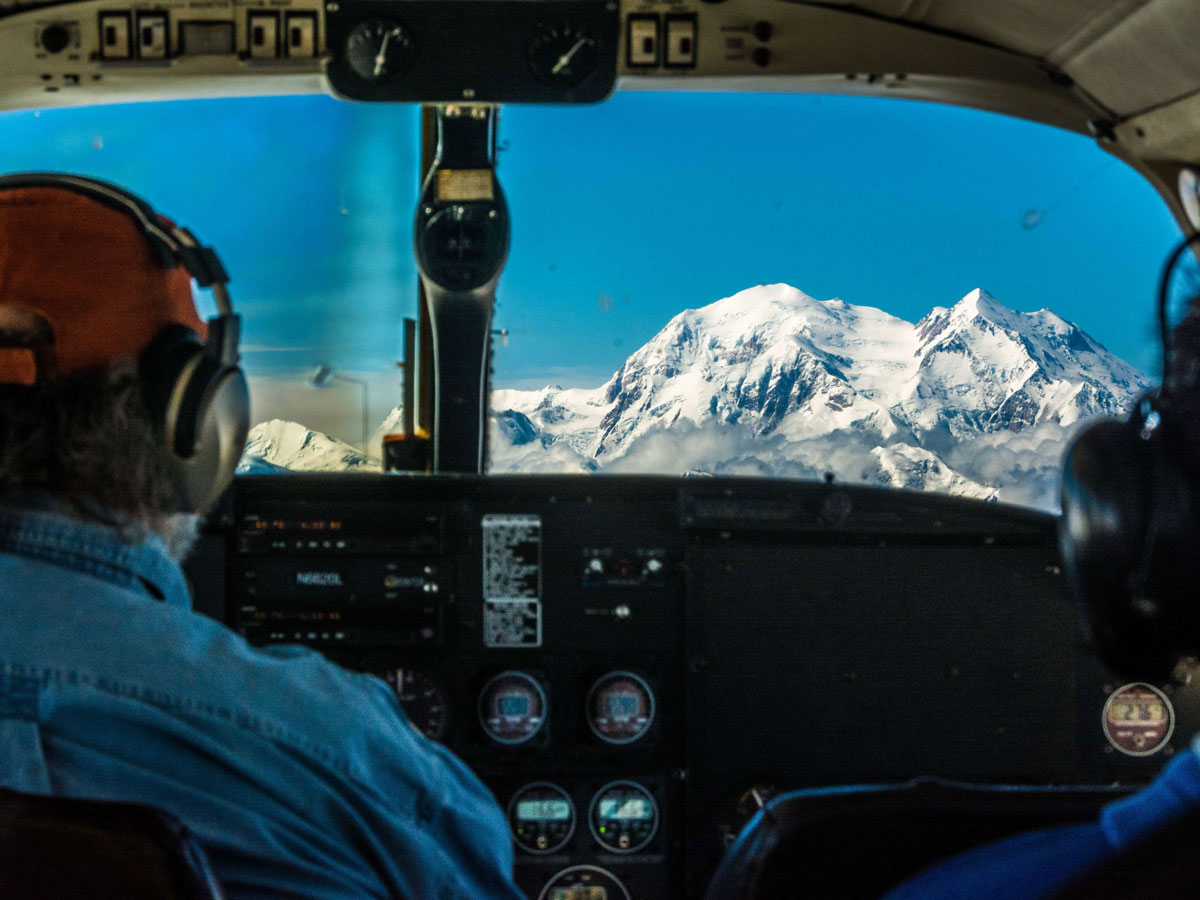Alaskan pilot and former UW student Roger Fuiten loves sharing the beauty of Denali with visitors
After dreaming about it for years, Roger Fuiten hitchhiked to Alaska to begin a new career with high risks and high rewards.

Former UW student Roger Fuiten has seen what Alaska has to offer from the air. As a pilot, he has carried tourists and explorers all over the state. Photo: George Spencer.
At 20,310 feet, Denali looms large over Alaska’s landscape—and in the imaginations of people who live and travel there. It’s the continent’s tallest peak. For centuries Alaska Natives called the mountain (in various languages) The High One, The Tall One, The Mighty One and even The Shy One because this granite monolith is so massive, it creates its own weather system that often blocks it from view.
Roger Fuiten, 71, calls Denali the place where he works. He’s an air taxi pilot for the flightseeing company Denali Air. For the past 25 years, he has spent his summers jumping off the gravel airstrip at the edge of Denali National Park & Preserve in a single-engine, seven-seat Cessna 206 to show visitors the sights.
A mountaineer in his youth, Fuiten summited two other major peaks in the Alaska Range: 13,220-foot Mount Silverthrone and 11,890-foot Mount Brooks. While flying, he still scrutinizes routes on the mountains. “I think about how people would climb them or how I would approach them,” he says.
But Fuiten mostly views the forbidding yet awe-inspiring scenery as a pilot should. On a clear day, pennants of snow stream from Denali’s rocky facets. “I’m looking at the snow blowing off the summit and trying to estimate the wind’s speed and direction,” he says. “That’ll tell me where I’m going to get turbulence or downdrafts. I’m not just looking at the mountain from a grandeur perspective.”
Navigating a tiny propeller plane around such rugged scenery never gets old. “Every trip is different. Every group is different. I get enjoyment sharing Denali with other people who haven’t seen it before,” says the Hillsboro, Oregon, native.
The son of a mail carrier and homebuilder, Fuiten has that quiet, confident voice common among commercial pilots, as well as kindly eyes and big, toothy grin. He fell in love with Alaska’s frontier spirit during a family vacation there when he was 15. After finishing high school, he worked on a framing crew building houses. “I was always talking about going to Alaska. My friends said, ‘Don’t talk about it—do it,’” he recalls.
So, when he was 20 in 1973, he hitchhiked 2,500 miles to Denali National Park, an expanse larger than New Hampshire. He got a job as a shuttle bus driver and put down roots.
“I was very frugal. My friends and I would carpool to go to Fairbanks 130 miles away. Nobody had any money,” he says. Soon he landed work outdoors in the winter on a seismic exploration crew looking for oil and gas deposits. By 1975, he had saved enough to buy a parcel in the village of Denali next to the park. He built a 12-by-20-foot log cabin where he lived for 40 years.
- A Piper Chieftan soars near Denali. Photo courtesy of Denali Air.
- The view of Denali from the cockpit. Photo by Jesse Campo, courtesy of Denali Air.
Remote central Alaska was still the frontier. “Getting a moose was a pretty important part of getting ready for winter. It’s not like that now,” he says. “If anything, being around Denali now, there’s a large group of people who are anti-hunting.” Many locals are now snowbirds who leave to avoid the long, harsh winters. “They’re only here for the money, because it’s easy to get a job here in the summer.”
Fuiten always wanted to learn new trades. “I’ve always seen opportunities that other people didn’t want to go after,” he says. For 31 years, he worked as a construction superintendent for the state’s Indian Health Service, putting in water and sewer lines in Native villages. He has a blasting license and does explosives work for companies in Anchorage and Wasilla. (His UW extension class taught him a safer method of blasting that uses non-electric initiators.) And he owns a Caterpillar excavator and hires himself out to local contractors.
“What do you say about a guy who’s a pilot, a heavy-equipment operator, mechanic and an explosive expert? He’s a real Renaissance guy for Alaska,” says Fuiten’s former co-worker Peter Bilbo. “If he’s your friend, he’s a friend for life.”
That’s a lesson a fellow climber learned when Fuiten rescued him during their 1975 Mt. Silverthrone trek. For Fuiten, the 45-day journey involved cross-country skiing for 200 miles. Four other climbers flew to a meeting point. While coming off the mountain on the Brooks Glacier, the man he was roped to fell into a crevasse. He clung to its edge, his legs dangling in the air, unable to pull himself out. Fuiten thrust his ice axe in the snow, wrapped his line around it, and sat on it to secure himself and his partner until the other three men reached them.
“That was probably one of the most interesting parts of the trip,” he deadpans.
The party also found a buried cache of provisions. In 1944, the Army’s 10th Mountain Division had done cold-weather equipment testing in Denali. Besides parachutes and snow goggles, he pulled out a case of frozen K rations.
Because the climbers spent an unplanned extra week on the mountain, they ran out of food. All Fuiten had to eat during his solo trek out were 2 lbs. of Swiss chocolate and seven cans of 31-year-old corned pork.
When flying tourists, he tells them about that expedition and his other adventures in the park. “People are interested, but a lot of them don’t even believe me.”
Fuiten earned his pilot’s license in 1978 after buying an Air Force surplus Cessna O-1 Bird Dog, which had been an observation aircraft. He will always remember a close call in 2003. While flying across the Shelikof Strait from Kodiak to Chignik, his engine started to run hot. He knew it might soon conk out. He was five miles offshore at 14,500 feet. Thick clouds prevented him from seeing a place to land.
Though he had declared Mayday and spoke with another pilot, he soon lost radio contact. “The coastline was real rocky, cliffy. I descended into the clouds and broke out at 2,000 feet with three-quarters of an inch of ice on my wings,” says Fuiten.
He spotted a 1,000-foot-long beach and made it down. “The tide was coming in. The beach was only 25 feet wide,” he recalls. Suspecting that water had got in his fuel line and frozen, he fixed the problem and leapt off the beach before the tide rose. “I was so lucky in so many ways, and I did everything right,” he says.

